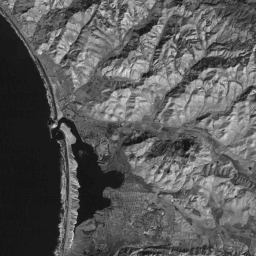
We are now ready to enter the last two phases of this Tutorial on image display and interpretation. We will embark first on a quick "tour" through images produced by PCA or Principal Components Analysis. In producing these, we will utilize all 7 bands and request that the all 7 components be generated (the number of components is fixed by the number of bands, being equal). The first Principal Component will "explain" the maximum amount of variation in the 7 dimensional space defined by the 7 Thematic Mapper bands. Keeping in mind that many of the tonal patterns in individual components do not seem to spatially match specific features or classes identified in the TM bands and represent linear combinations of the original values instead, we will now look at each of these components but will make only limited comments on the nature of those patterns that lend themselves to some interpretation.
The image produced from PC 1 data commonly resembles an actual aerial photograph.

In fact, this is the normal character of the first component in that it both simulates standard black and white photography and it contains most of the pertinent information inherent to a scene. The hills are more realistically imaged because the sharp bright-dark contrast evident in most TM bands alone has been subdued. Note the internal structure of the waves and the absence of any indication of sediment load in the sea. The histogram of the first PC shows two peaks. The first, on the left,constitutes the ocean pixels and the second one, to the right, the land pixels.
When we look at the histogram of the second PC, we see that even though the total range (maximum value - minimum value) is greater than for the first PC, most of the pixels fall in a small range around the mean of 49. Thus as is the convention the second PC has a smaller variance (variance = standard deviation squared) than the first PC. Since the bulk of the pixels fall in such a narrow range, the image does not display well (left). In order to make the image viewable (right),


we will expand (stretch numerically) it and then apply a histogram equalization to the results. This procedure (histogram equalization) produces a histogram where the space between the most frequent values is increased and the less frequent values are combined and compressed. If we had not done this transformation, the image would appear tonally flat as above, with only two gray levels defining most of the land surfaces and one the ocean. However with the distinctions that were previously small are now magnified and easier to see on the computer display. The breaker waves are uniquely singled out as very bright.
Much of the gray patterns in the PC3 image below can be broadly correlated with two combined classes of vegetation:

the brighter tones associate with the fairways in the golf course and with many of the agricultural fields. Moderately darker tones coincide with some of the grasslands, forest or tree areas, and coastal marshland.
The breakers completely disappear in the PC4 image below while the rest of the scene tends to rather flat with several patterns set forth in medium grays.

Any three of these four PC images can be made into color composites with various assignments of blue, green, and red; all told, 24 different combinations are possible. Of those made experimentally for this review, this next image

composed of PC 4 = blue, PC 1 = green, and PC 3 = red has proved most interesting. In this rendition, the golf course has a singular color signature - being orange-red - singled out further by its internal structure. Most other vegetation is defined by red to purple-red tones but the grasslands (v) has an unusual color describable as "greenish-orange". The brighter slopes of the hills and mountains show up a medium green while some areas in shadow are bluish. The urban areas also have a deep blue color. The beach bar now appears as a turquoise and the adjacent breakers are shown as olive-green.
Code 935, Goddard Space Flight Center, NASA
Written by: Nicholas M. Short, Sr. email: nmshort@epix.net
and
Jon Robinson email: Jon.W.Robinson.1@gsfc.nasa.gov
Webmaster: Bill Dickinson Jr. email: rstwebmaster@gsti.com
Web Production: Christiane Robinson, Terri Ho and Nannette Fekete
Updated: 1999.03.15.